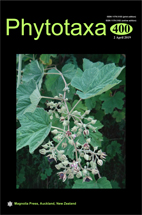Abstract
During field studies of the inselbergs of northeastern Brazil, two potentially new species of were discovered. They share morphological characters with several genera of Linderniaceae (Lamiales) such as Ameroglossum, Cubitanthus and Stemodiopsis, but the morphological differences are such that they do not make a good fit with any of the known genera in Linderniaceae. They are most likely related to Ameroglossum, and like most members of this genus the plants have a conserved chromosome number of 2n = 60. Their exclusive occurrence on inselbergs in northeastern Brazil also hint at this relationship, but because their morphology differs greatly from Ameroglossum and each other, the two new species are described in separate genera. Catimbaua is a pendent plant somewhat similar to Cubitanthus, but with different stem morphology and indumentum. Isabelcristinia grows in habitats similar to, but drier than, Ameroglossum and is vegetatively similar. However, it is covered in glandular hairs and has open-throated white flowers rather than the red or orange tubular flowers found in Ameroglossum. Catimbaua pendula and Isabelcristinia aromatica are rare, and both are likely to fall in a category of threat.

